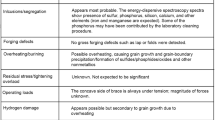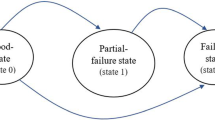Abstract
Reliability indices of a redundant system of two identical units—one is initially operative and the other is kept as spare in cold standby are derived by using semi-Markov process and regenerative point technique. The system model is developed by considering the aspects of standby failure and inspection. There is a single server who visits the system immediately to carry out repair activities as and when required. The unit in cold standby mode may fail after surpassing a pre specified time ‘t’. The server inspects the standby unit at its failure to see feasibility of repair. If repair of the standby unit is not feasible, it is replaced immediately by new one. However, repair of the operating unit at its failure is done without inspection. The random variables are statistically independent. Repairs and switch devices are perfect. The failure time of unit follows exponential distribution whereas repair and replacement times follow arbitrary distribution. The practical significance of the results is illustrated through numerical example.
Similar content being viewed by others
References
Bhardwaj RK, Singh R (2014) Semi Markov approach for asymptotic performance analysis of a standby system with server failure. Int J Comput Appl 98(3):9–14
Cox DR (1962) Renewal theory. Methuen, London
Eryilmaz S (2013) Reliability of a k-out-of-n system equipped with a single warm standby component. IEEE Trans Reliab 62(2):499–503
Gopalan MN (1975) Technical note—probabilistic analysis of a single-server n-unit system with (n − 1) warm standbys. Oper Res 23(3):591–598
Hajeeh MA (2014) Performance evaluation and cost analysis of standby systems. Int J Mech Aerosp Ind Mechatron Eng 8(1):103–106
Ibe O (2008) Markov processes for stochastic modeling. Academic Press, London
Jain M, Sharma GC, Sharma R (2008) Performance modeling of state dependent system with mixed standbys and two modes of failure. Appl Math Model 32(5):712–724
Jia J, Wu S (2009) Optimizing replacement policy for a cold-standby system with waiting repair times. Appl Math Comput 214(1):133–141
Osaki S, Nakagawa T (1971) On a two-unit standby redundant system with standby failure. Oper Res 19(2):510–523
Pandey D, Jacob M, Yadav J (1996) Reliability analysis of a power loom plant with cold standby for its strategic unit. Microelectron Reliab 36(1):115–119
Singh SK, Agrafiotis GK (1995) Stochastic analysis of a two-unit cold standby system subject to maximum operation and repair time. Microelectron Reliab 35(12):1489–1493
Smith WL (1955) Regenerative stochastic processes. Proc R Soc Lond A 232(1188):6–31
Smith WL (1958) Renewal theory and its ramifications. J R Stat Soc Ser B (Methodol) 20(2):243–302
Srinivasan SK, Subramanian R (2006) Reliability analysis of a three unit warm standby redundant system with repair. Ann Oper Res 143(1):227–235
Subramanian R, Anantharaman V (1995) Probabilistic analysis of a three unit cold standby redundant system with repair. Microelectron Reliab 35(6):1001–1008
Wang KH, Lai YJ, Ke JB (2004) Reliability and sensitivity analysis of a system with warm standbys and a repairable service station. Int J Oper Res 1(1):61–70
Wells CE (2014) Reliability analysis of a single warm-standby system subject to repairable and non- repairable failures. Eur J Oper Res 235:180–186
Yakimiv AL (2005) Probabilistic applications of Tauberian theorems. V.S.P. Intl. Science, Boston
Yuan L, Meng XY (2011) Reliability analysis of a warm standby repairable system with priority in use. Appl Math Model 35(9):4295–4303
Zhong C, Jin H (2014) A novel optimal preventive maintenance policy for a cold standby system based on semi-Markov theory. Eur J Oper Res 232(2):405–411
Acknowledgments
The authors would like to thank the reviewer and managing editor for valuable comments for improving the manuscript. The second author, Ms Komaldeep Kaur is working as INSPIRE Fellow under INSPIRE Programme of DST, Govt. of India.
Author information
Authors and Affiliations
Corresponding author
Ethics declarations
Conflict of interest
None.
Rights and permissions
About this article
Cite this article
Bhardwaj, R.K., Kaur, K. & Malik, S.C. Reliability indices of a redundant system with standby failure and arbitrary distribution for repair and replacement times. Int J Syst Assur Eng Manag 8, 423–431 (2017). https://doi.org/10.1007/s13198-016-0445-z
Received:
Published:
Issue Date:
DOI: https://doi.org/10.1007/s13198-016-0445-z




